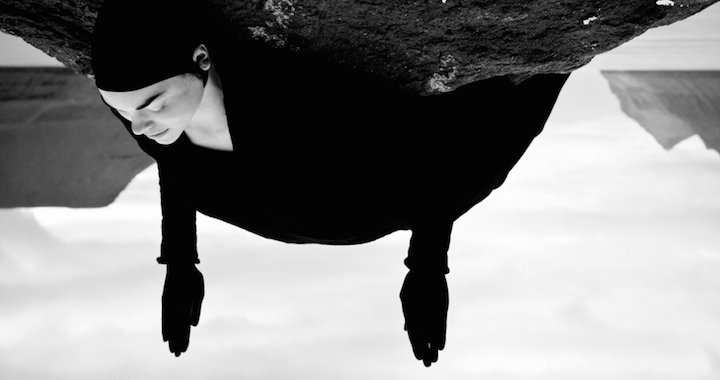
Exhibition, Book and Film: “The Weather Diaries”
Arterritory.com
10/11/2014
The Weather Diaries Exhibition
Curated by Cooper & Gorfer
National Museum of Photography / Black Diamond, Copenhagen
November 1, 2014 – May 25, 2015
On assignment from The Nordic House Iceland, the curators of the Nordic Fashion Biennale, Sarah Cooper and Nina Gorfer (aka the artistic duo Cooper & Gorfer), traveled throughout Iceland, Greenland and the Faroe Islands to explore the roots of West Nordic fashion. The resulting body of work is a prolific collaboration between the artistic duo and 12 remarkable fashion talents of the West Nordic Islands.
Place and story are often the catalysts in the duo's work and method, in which they transform narratives and memory into image. Cooper & Gorfer undertake intensive research and photographic studies that examine the underlying themes with which to approach their projects. For “The Weather Diaries”, they continued with this method and spoke with many of the designers and artists about their childhood, cultural identity, and the effects of isolation as manifested in their own lives and creative works.
“The history of weather and its vibrant – and sometimes violent – existence, as experienced by them, became an inescapable theme weaving its way in and out of our discussions. The title “The Weather Diaries” became, in the end, a narrative force and metaphor for many of the themes addressed in the exhibition. The West Nordic islands – Iceland, Greenland and the Faroe Islands – are subject to extreme weather conditions and seasonal periods of total darkness and light. By using the dialogue of nature’s strength as a red thread, we sought to create an umbrella under which the roots of West Nordic Fashion and its inimitable creativity and aesthetics could be explored and molded. In the end, “The Weather Diaries” series deals with humanity's urge to create and adorn oneself while addressing fashion, and how fashion has always coexisted within the symbols and metaphors used within art”, explain Cooper & Gorfer.
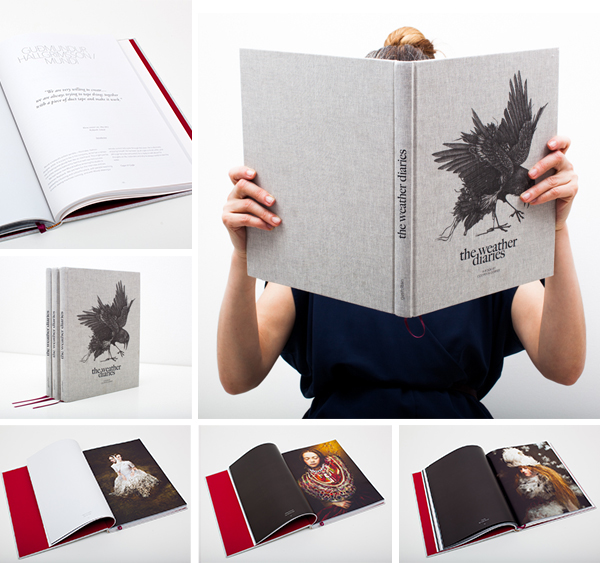
Book: “The Weather Diaries”
We asked the duo to give us their concise interpretation of Nordic aesthetics:
Nina Gorfer: I would say that the North is very diverse, once you start looking into it closer. We experienced the aesthetic of the West Nordic Islands as being quite different from the rest of Scandinavia. The Scandinavian attributes of reduced, simplistic and functional design don’t really apply there. Take Iceland, for example: it has developed an uncompromising creativity, a fearlessness towards the creative process. Where Scandinavian design strives for a reduced, natural simplicity, Icelandic creativity is more immediate and uncompromising; somehow, less designed to please, less commercial and more moody and capricious – like the weather! The Faroe Islands and Greenland have stories and histories of their own, whereas the similarities between the Faroe Islands and Iceland are much more aesthetically obvious. Greenland has just started its journey towards its own new aesthetic.
Coming from Austria, I would, of course, still say that there is a uniting base uniting all of the Northern countries: “naturalness” tends to be a binding constant. From a naturalness in material to a natural and untamed creative process, there is a beautiful refined rawness in Nordic expression. Where even the most avant-garde designers, like the Faroe Islands' Barbara I Gongini, will use sustainably produced fabrics and production processes. It’s an implicitness rather than an add-on. To me, it seems that the North has come far in its awareness of nature and our impact on the planet in an age of consumerism. This consciousness seems to translate into a Northern aesthetic that speaks to so many because it reminds us of a more immediate self.
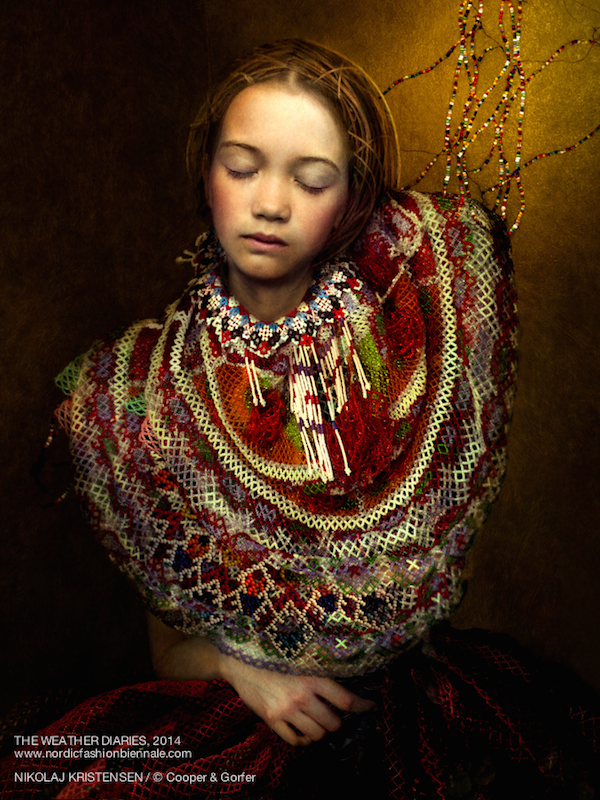
Sarah Cooper: There is a kind of underlying fearlessness in the aesthetics of the North. Something you would maybe first associate with Björk is resonating in the West Nordic Islands. Due to their geographical isolation, normal market values of commercialism don’t quite infiltrate the society as heavily as, say, in a place like Sweden or Paris. And as a result, the expression of the work seems to be dictated by something more instinctive and emotional.
For example, Iceland’s creative talent, Mundi – whose unconventional and almost sci-fi fashions come from the breeding ground of his alchemistic world filled with riddles. Or the avant-garde works of the Faroe Island's Barbara Í Gongini, which have a futuristically rebellious nature to them and stand in contrast to the traditions of the Faroe Islands, yet the impeccable craftsmanship behind these bizarre and exquisite garments is rooted in the expertise of centuries of traditional crochet and knitting methods.
The works of many of these designers and artists from the West Nordic Region is sincere and honest. Some have a ground-breaking and eruptive aesthetic, such as the artwork of Hrafnhildur Arnardóttir, aka Shoplifter (IS), or a more dark and almost mystical mood to them, such as the fashions of Steinunn (IS) and Barbara Í Gongini (FO), or the artistically choreographed films of Rammatik (FO). Others give rise to a fresh twist on tradition, like in the Greenlandic street styles of Bibi Chemnitz (GL), or the beautifully tailored suits of Jör by Guðmundur Jörundsson (IS).
But all in all, there is a storytelling-like aspect to the works from this region, as can be seen by the intricate craftsmanship and identity lovingly presented in them – such as the jewellery of Kría, with its shamanistic references (IS); the pearl dresses of Nikolaj Kristensen (GL); the artworks of Jessie Kleemann (GL); and the narrative knitwear of Guðrun & Guðrun (FO).
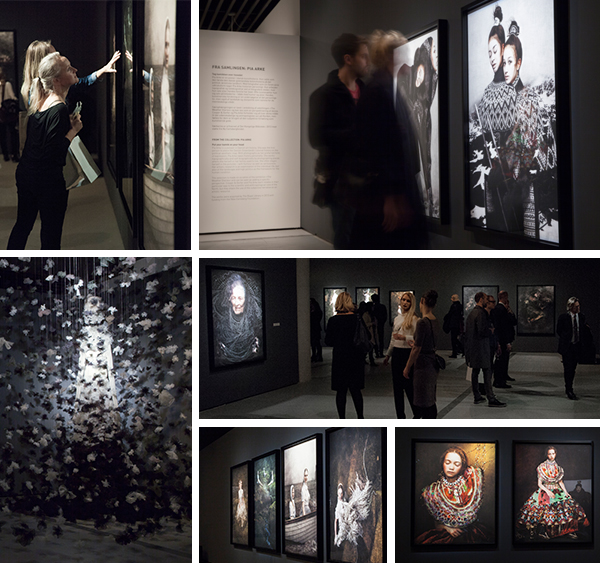
Exhibition at National Museum of Photography / Black Diamond, Copenhagen: “The Weather Diaries”
Do northern weather conditions cause fashion to evolve differently than in other parts of the world?
Nina Gorfer: I have to say that both Sarah and I have always had a fascination for the North. Our collaboration began with a trip to Iceland and we both left our home countries for Sweden, where we have lived for the last 10 and 14 years, respectively. So we are quite used to the North! However, Iceland, Greenland and the Faroe Islands have something that differentiates them from the rest of Scandinavia. All of them are harsh in their own ways, with the weather being a constant – it is almost an entity of its own, impacting you on a daily basis. And here we don’t talk about if you should leave the house with an umbrella or not, but about a very concrete and real influence on your emotional body, on your daily life as well as your life at large, and last but not least, on your creativity. And this is what we had set out to investigate – how does the weather, the isolation of living on an island, and the merciless seasonal darkness and light impact or even alter you? One quote comes to mind here: The Icelandic artist Hrafnhildur Arnardóttir, aka Shoplifter, said in our interview with her: “The fact that you are living on this live rock in the middle of the ocean and feeling the constant throbbing of its isolation – it affects you.”
Sarah Cooper: There is something quite innocent and primal when you are exposed to the elements so clearly up in the north. It is a developed society with a life that functions and flows as usual, yet you can feel and see the fragility and consequences of your, and others’, decisions. Now I can see it as a fascination, the way you are so literally humbled by nature, especially in the rhetoric of climate change. But the reality of these decisions – that they are normally tied to survival – is something that is so explicitly raw up there. We learned it the hard way, tumbling off the road in our car after a harsh blizzard in Iceland in 2005. We were too stubborn to follow the weather directives announced earlier that same morning.
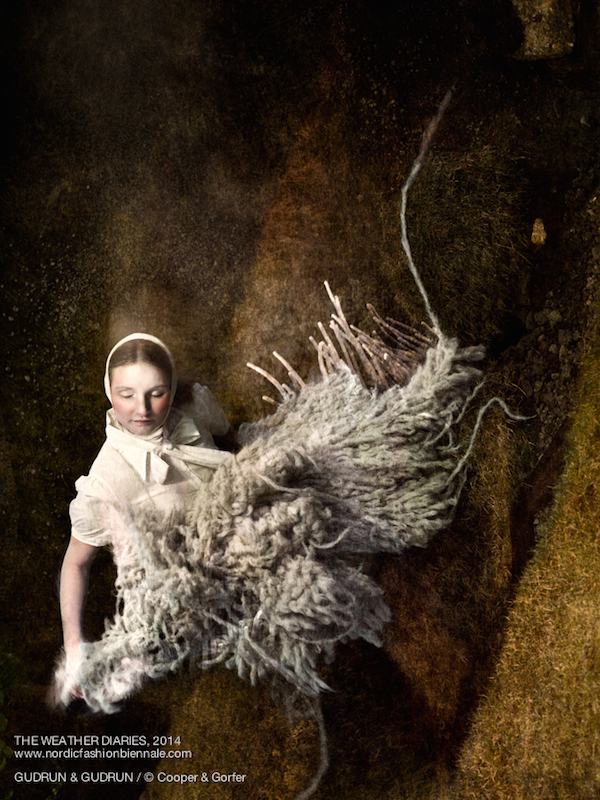
What kind of fashion conditions did today's Nordic fashion artists grow up under? What was the fashion like 20 – 40 years ago?
We highly recommend reading the interviews in “The Weather Diaries” book – specifically Kría's and Shoplifter's – they speak of growing up playing with bones, and having little access to fashion, and how that has lead to a wild form of creativity.
How, in their opinion, is fashion changing today? Do these changes differ from region to region?
Cooper & Gorfer: Yes, there is a sense of concern in this region. With the recent economic crisis and the volcanic eruptions in Iceland, you see the vulnerability of nature and life itself. You have a moral consciousness coming out of these regions (cultural heritage, sustainability). There was a beautiful story that Jessie Kleemann told us, and which became an immense inspiration for us – not only for the Greenlandic part of the project, but for the project as a whole. It was the story of Sassuma Arnaa, The Mother of the Sea. It beautifully describes the Nordic understanding of the connection between humanity and nature: if you don’t treat nature with respect, it will fall back on you. The image, “Ena Holds the Sea”, addresses this theme.
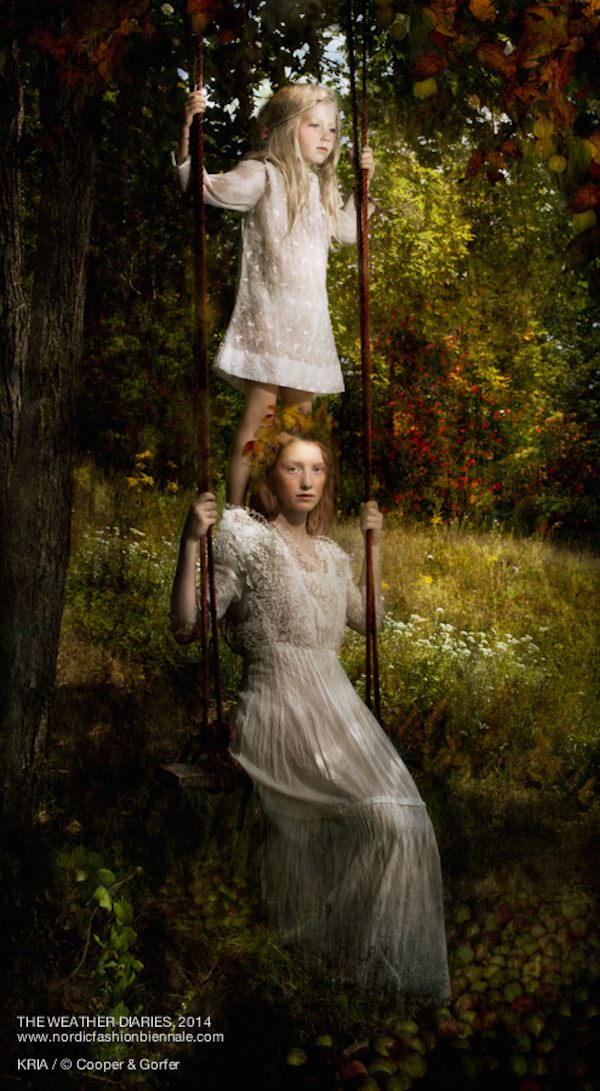
Could you briefly describe the preparation and research you put in for the making of “The Weather Diaries” (published by Gestalten)?
Cooper & Gorfer: The subjects of cultural heritage, history, folklore and identity play a large roll in our work, and we tend to revolve around these themes both visually and practically. Most of our works deal with foreign locations and cultures, with a premise of bringing a deeper insight into the lives and histories of peoples seldom addressed in the daily discourse of our lives. That said, and despite the foreign aspect – our work, most importantly, strives for an emotional recognition of the familiar as it relates to the shared human aspect, rather than cultivating cultural differences. Our comprehensive research grounds our work by binding the imaginative visual language associated with our work to an aspect of reality.
For “The Weather Diaries” project, the set-up and subject matter were different from our other art series. Foremost, it was a commissioned project with a clear agenda and a defined subject matter – namely, fashion from the West Nordic Islands. Because of this and the logistics and sheer magnitude of the project, many important creative decisions had to be taken in the beginning. The research and travel period was meticulously planned before we physically went on our travels. The intensity of the administration and pre-planning stood in sharp contrast to our other art projects, in the sense that most of the research was done on location – we left space for coincidence, to having an open mind for what we would find or experience, what sort of people we would meet, and where all that would then lead us.
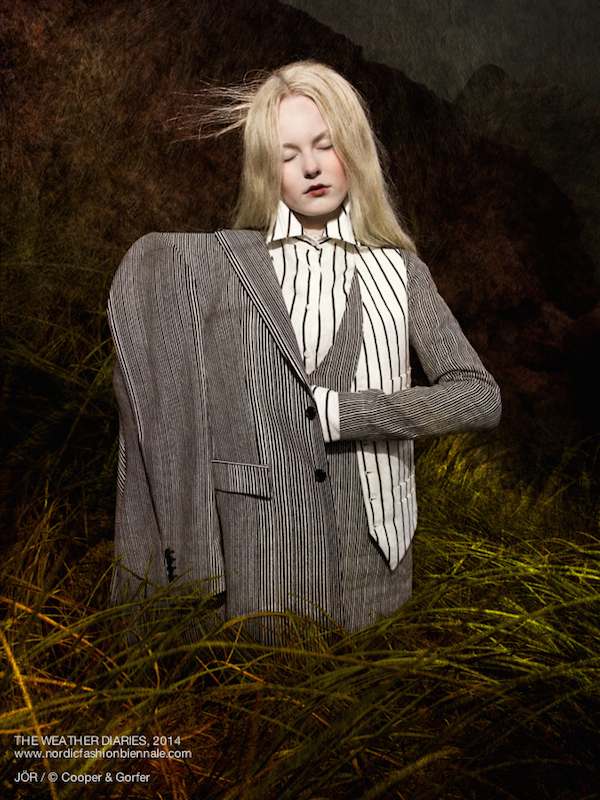
But despite the conundrum of extensive pre-planning for “The Weather Diaries”, the research method remained rather unscathed. Flow-driven interviews with the designers and creatives are the essence of this work. Research of archives, discussions with artists, historians, grandmothers, and experts of cultural heritage were directly focused on the preset subject of fashion from the West Nordic. All of these interviews, talks and discussions became the base of the project and the creative seed for the collaborations with the designers, their installations and our photographic works. They also offered us the opportunity to provide a more in-depth analysis and reflection around the topics we wanted to highlight, in which the title of the project, “The Weather Diaries”, became a metaphor for the questions posed: How does weather and isolation influence creativity? Do designers from these countries differ in their philosophy of production and consumerism as compared to the fashion circus found in the centers of fashion industry elsewhere in the world? How does this proximity to the spectacles of nature’s power impact the creative mind? And lastly, what drives humans to create items with which to adorn themselves in the first place?
When it came to our choice of designers and creatives with which to collaborate, it was important to us to show the wide range of fashion out there, but at the same time, to keep a close and personal rapport with the people we had chosen. Our selection was, therefore, tight in terms of the number of people featured, but broad in terms of expression and approach. From the cross-media artist and fashion designer MUNDI, to Greenland's Nikolaj Kristensen, who beads dresses for his daughter in a tiny isolated fishing village in Northwest Greenland (which illustrates the innate human need for aesthetics and adornment). It was a challenge to unite these very different individuals and creative minds, but in the end, it came together beautifully – the differences are still tangible, like different characters in a story.
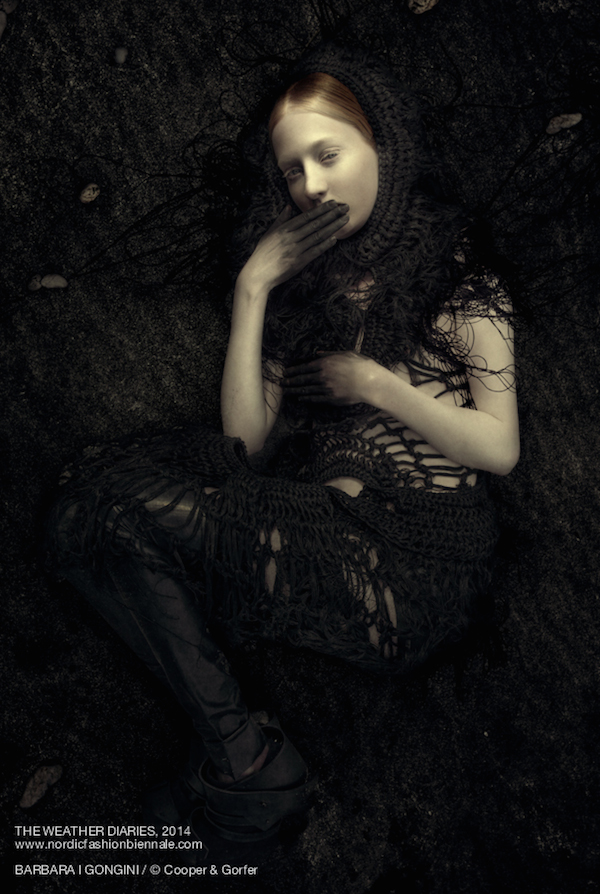
The photographs for the book were shot on location throughout Iceland, the Faroe Islands and Greenland. Could you tell us more about the creative process behind them – how did you find the locations? How did you come up with the references to eighteenth- and nineteenth-century paintings?
Cooper & Gorfer: Our images are always staged and carefully directed. We use a portable flash light system to create stage-like lighting. The process of shooting, however, remains fluid and intuitive. For “The Weather Diaries”, we were photographing on location in Greenland, Iceland and the Faroe Islands, so naturally, the weather influenced a lot of our decisions. If the wind is gusting more than 20m per second, or if suddenly a snowstorm rolls in, the amount of time one can endure both behind and in front of the camera is limited.
Art and clothing have always been synonymous with one another – here we touch upon art history references while addressing the Danish colonial infiltration that formally encompassed the West Nordic Island region.
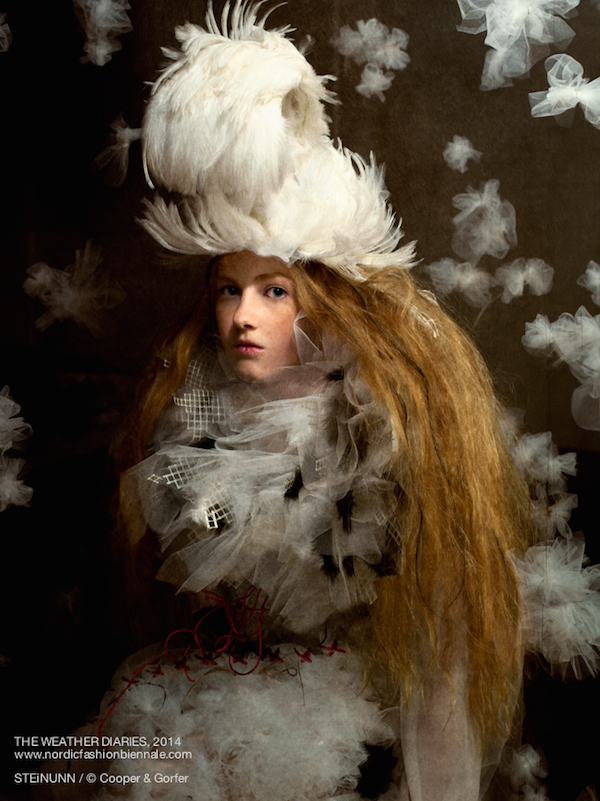
For example, you see this in the image “Malu at Kangerlua Fjord, Holding Two Spit Skinned Birds”, in which the girl is wearing a black dress reminiscent of an 18th-century European gown, but shorter – as to not disturb the Greenlandic boots. In this image, too, Greenland meets Denmark in its own kind of interpretation and adaption. It's an earnest, but at the same time, playful study of an another, ulterior present – one in which the merging of cultures results in an altogether different costume, packaged within a reference to Western colonial painting.